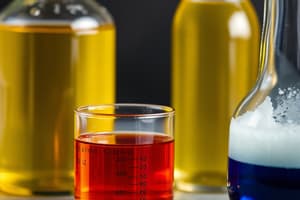Podcast
Questions and Answers
Which blocks of the periodic table contain metals?
Which blocks of the periodic table contain metals?
- s-block and p-block
- s-block, d-block, and f-block (correct)
- d-block and f-block
- p-block and d-block
What characteristic contributes to the high reactivity of metals?
What characteristic contributes to the high reactivity of metals?
- Low ionization energy (correct)
- Low electron affinity
- High electronegativity
- High ionization energy
Which element is sometimes classified as a metalloid but is more commonly categorized differently?
Which element is sometimes classified as a metalloid but is more commonly categorized differently?
- Germanium
- Boron
- Polonium (correct)
- Silicon
What type of bond typically forms between two nonmetals?
What type of bond typically forms between two nonmetals?
Which property is NOT shared by all metalloids under standard conditions?
Which property is NOT shared by all metalloids under standard conditions?
Where are nonmetals primarily located on the periodic table?
Where are nonmetals primarily located on the periodic table?
Which of the following is an example of a gas-solid solution?
Which of the following is an example of a gas-solid solution?
What distinguishes a homogenous mixture from a heterogenous mixture?
What distinguishes a homogenous mixture from a heterogenous mixture?
Which of the following best describes a suspension?
Which of the following best describes a suspension?
What is the key characteristic of a colloid?
What is the key characteristic of a colloid?
How are mixtures different from compounds?
How are mixtures different from compounds?
Which of the following is considered a pure substance?
Which of the following is considered a pure substance?
What is the ideal purity percentage of a pure substance?
What is the ideal purity percentage of a pure substance?
When an ionic compound dissolves in a solvent, it:
When an ionic compound dissolves in a solvent, it:
Which of the following mixtures would be classified as heterogeneous?
Which of the following mixtures would be classified as heterogeneous?
What method is used to increase the purity of a substance like water?
What method is used to increase the purity of a substance like water?
Which of the following is NOT an example of a pure substance?
Which of the following is NOT an example of a pure substance?
How can the physical properties of a pure substance aid in its identification?
How can the physical properties of a pure substance aid in its identification?
Why are pure substances valued in chemical research?
Why are pure substances valued in chemical research?
What type of mixture is saltwater?
What type of mixture is saltwater?
What does a retention factor (Rf) of 0.25 indicate in chromatography?
What does a retention factor (Rf) of 0.25 indicate in chromatography?
What principle is employed by both evaporation and crystallization for separating mixtures?
What principle is employed by both evaporation and crystallization for separating mixtures?
Which subatomic particle has no charge and a mass of 1 amu?
Which subatomic particle has no charge and a mass of 1 amu?
What does the atomic number (Z) of an element represent?
What does the atomic number (Z) of an element represent?
What is the term for atoms of the same element with different numbers of neutrons?
What is the term for atoms of the same element with different numbers of neutrons?
Flashcards
Solution
Solution
A homogeneous mixture of one or more solutes in a solvent.
Homogeneous mixture
Homogeneous mixture
A mixture with uniform composition where individual components cannot be seen.
Heterogeneous mixture
Heterogeneous mixture
A mixture with visibly different substances or phases.
Suspension
Suspension
Signup and view all the flashcards
Colloid
Colloid
Signup and view all the flashcards
Solid-Liquid Solution
Solid-Liquid Solution
Signup and view all the flashcards
Pure Substance
Pure Substance
Signup and view all the flashcards
Mixture
Mixture
Signup and view all the flashcards
Compound
Compound
Signup and view all the flashcards
Trends in Periodic Table
Trends in Periodic Table
Signup and view all the flashcards
Metals
Metals
Signup and view all the flashcards
Mealloids
Mealloids
Signup and view all the flashcards
Nonmetals
Nonmetals
Signup and view all the flashcards
Ionic Compound Formation
Ionic Compound Formation
Signup and view all the flashcards
Covalent Bonding
Covalent Bonding
Signup and view all the flashcards
Refining
Refining
Signup and view all the flashcards
Distillation
Distillation
Signup and view all the flashcards
Mass Number
Mass Number
Signup and view all the flashcards
Atomic Number (Z)
Atomic Number (Z)
Signup and view all the flashcards
Isotope
Isotope
Signup and view all the flashcards
Atomic Mass
Atomic Mass
Signup and view all the flashcards
Periodic Table
Periodic Table
Signup and view all the flashcards
Chromatography
Chromatography
Signup and view all the flashcards
Conductivity
Conductivity
Signup and view all the flashcards
Study Notes
Solutions and Mixtures
- Solutions are homogenous mixtures of one or more solutes dissolved in a solvent.
- Examples include sodas, seawater, air, and metal alloys.
- Solutions cannot visually differentiate their individual components.
- An ionic solute dissolved in a solvent dissociates into cations and anions.
- Solutions can be classified by the state of matter of solute and solvent:
- Solid-solid (e.g., bronze)
- Liquid-liquid (e.g., hand sanitizer)
- Gas-gas (e.g., air)
- Solid-liquid (e.g., sports drinks)
- Liquid-gas (e.g., sodas)
- Gas-solid (e.g., hydrogen gas and platinum)
- Heterogeneous mixtures have uneven distribution of constituent particles (e.g., sand and water).
- Suspensions are heterogeneous, separate into layers (e.g., sand in water).
- Colloids are heterogeneous, do not separate (e.g., milk).
- Mixtures have variable proportions of elements, making them impure substances.
Pure Substances
- Pure substances are made of one type of element or compound, for instance, table salt or water.
- Purity is measured, ideally 100%, but rarely achieved.
- Refining methods, like distillation, are used to improve purity.
- Pure substances have specific melting & boiling points.
- Conductivity can vary based on purity.
- Pure substances are predictable in chemical reactions.
Separation of Mixtures
- Mixtures are formed when two or more components are physically combined.
- Solutions and alloys are homogeneous mixtures (e.g., air, steel, saltwater, gasoline).
- Suspensions and colloids are heterogeneous mixtures (e.g., pizza, a bag of marbles, sandy water).
- Various physical methods separate mixture components (chromatography, distillation, evaporation, crystallization, filtration, magnetism, manual separation).
- Chromatography separates components based on different affinities for mobile and stationary phases.
- Retention factor (Rf) calculation: (distance traveled by component/distance traveled by solvent).
- Distillation separates mixtures based on differing boiling points.
- Evaporation/Crystallization separates mixtures based on vaporization.
- Filtration separates solids from liquids in heterogeneous mixtures.
- Dissolving, then separating, is useful for multiple component mixtures.
- Magnetism separates magnetic metals.
Atoms and Subatomic Particles
- Atoms consist of protons, neutrons, and electrons.
- Protons are positively charged, located in the nucleus, with a mass of 1 amu.
- Neutrons have no charge, located in the nucleus, with a mass of 1 amu.
- Electrons are negatively charged, outside the nucleus, with negligible mass.
- Atomic number (Z) is the number of protons in an atom's nucleus, unique to each element.
- Mass number (A) is the sum of protons and neutrons.
- Isotopes are atoms of the same element with different numbers of neutrons.
- Atomic mass is the weighted average of isotopes' mass numbers.
The Periodic Table
- The periodic table organizes elements based on atomic number (number of protons).
- Historical developments include Dobereiner's Law of Triads, Newlands' Law of Octaves, and Mendeleev's periodic table.
- Moseley arranged the modern periodic table based on proton number.
- Periods are horizontal rows, groups are vertical columns.
- Elements are classified as metals, nonmetals, or metalloids.
- Periodic trends predict element properties (e.g., valence electrons, atomic radius, ionization energy).
Metals
- Metals are shiny, hard, ductile, malleable, and good conductors.
- Five main metal groups: alkali, alkaline earth, transition, lanthanides, actinides.
- Alkali and alkaline earth metals are in the s-block.
- Transition metals are in the d-block.
- Lanthanides and actinides are in the f-block.
- Examples include iron, gold, silver, zinc.
- Low ionization energy leads to high reactivity.
- Metals form hydroxides, halides, and oxides.
- Transition, lanthanide, and actinide metals form complexes.
Metalloids
- Metalloids have properties of both metals and nonmetals.
- Examples include boron, silicon, germanium, arsenic, antimony, tellurium (and sometimes bismuth, polonium, astatine).
- They are typically solids, have a metallic luster, are brittle, and are semiconductors.
- Properties (melting/boiling point, reactivity) vary.
- Their behavior depends on valence electrons and involved elements in reactions.
Nonmetals
- Nonmetals typically have high ionization energies and electronegativities.
- They are poor conductors of heat and electricity.
- Nonmetals are reluctant to give up electrons.
- Majority of nonmetals are gases at room temperature; some are solids, one is a liquid
- Nonmetals form covalent bonds when reacting with each other.
- Located on the right side of the periodic table (except hydrogen).
- Common nonmetal families: halogens, noble gases, some metalloids.
Studying That Suits You
Use AI to generate personalized quizzes and flashcards to suit your learning preferences.




